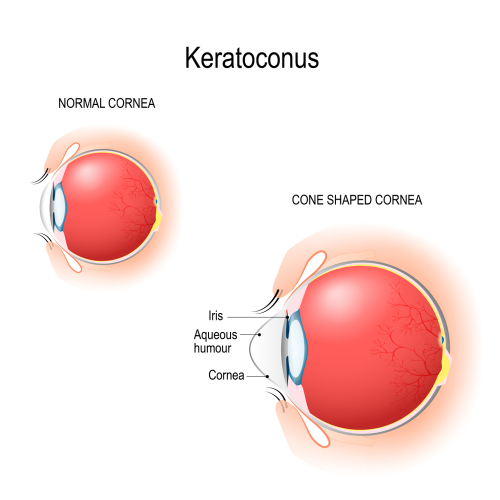
While you might not yet have heard of keratoconus, it is the most common form of corneal dystrophy. Whether this is your first time becoming aware of the issue or you, a friend, or family member have experience with it, it is important to be aware of this common problem that affects one in 2000 Americans. Luckily, thanks to the cutting-edge care offered by skilled professionals such as those at Silk Vision & Surgical Center, it may be possible for the progression os keratoconus to be slowed or stopped.
What is keratoconus?
Keratoconus is a disease affecting the cornea, the part of the eye through which light travels. Because this is the first point in light’s path through the eye to the brain, a normal corneal surface is essential in delivering a clear image to one’s mind. Keratoconus, a disorder that primarily affects teens and those in their 20s, is a result of a gradual thinning of the center of the cornea. Eventually, the middle of the cornea bulges outwards due to this thinning. This distorts one’s vision, leading to astigmatism and blurriness. There are many potential causes for keratoconus, but it is treatable, especially when dealt with in a timely manner.
How can keratoconus be treated?
For many patients, the cornea will stabilize on its own and keratoconus will correct itself. However, for a significant proportion of those affected, surgery may be required in order to restore vision. Thankfully, recent advancements have made keratoconus more treatable than ever before, without the worry of a surgical procedure. Silk Vision is proud to offer corneal collagen cross-linking, a permanent non-surgical procedure that has been shown to halt the progression of keratoconus. This groundbreaking step moves farther in improving the vision of those suffering from keratoconus than any previous treatment.
Cross-linking works through a single application of riboflavin eye drops, which are then activated through exposure to UV light. This results in the activation of cross-links within the stroma, ultimately restoring some of the cornea’s strength. While cross-linking is not a cure for keratoconus, its ability to slow or stop the worsening of the disorder is a wonderful step in improving patients’ vision. Preventing the disease from advancing stops vision from worsening or deteriorating to the point that corneal transplants might be required.
Another treatment that corrects the corneal misshaping caused by keratoconus is the installation of Intacs. Intacs are inserts that are surgically placed beneath patients' corneas in order to reshape it, improving vision. The procedure is very effective in lessening or eliminating the impact that keratoconus has on your vision.
If you want to know more about keratoconus or the cross-linking procedure, we at Silk Vision would be more than happy to answer your questions. Call us at (703) 876-9700 or schedule an appointment online today.











.png)
